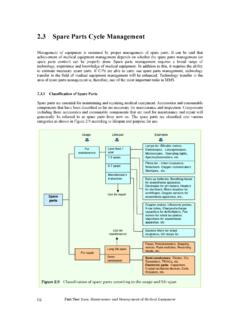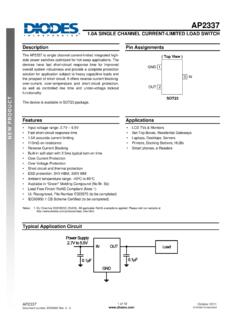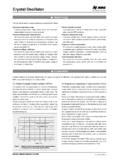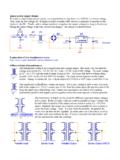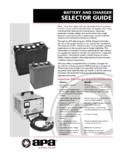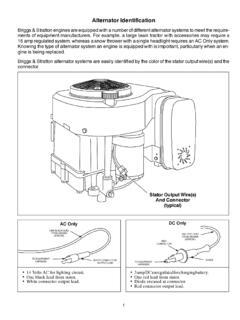Transcription of Updating Your Ripple Voltage Tutorial - Vensel …
1 Updating your Ripple Voltage Tutorial By Juan Grube Usually the phone call goes something like this: What are the specs for Ripple Voltage ? My answer is none! Then I ask what s driving the question. The answer is almost always that a good customer rejected an alternator for to much Ripple Voltage . When I ask what number he used, the answer is that he just said his tester s red light came on. Then I ask what his tester s operation manual says is the amount of Ripple that makes the light come on and when was it printed? Before we have a chance to discuss that question I make this statement: I know of no OEM alternator manufacturer who provides a specification for Ripple Voltage for testing either off or on the vehicle. Now if the guy that designed and made the alternator chooses to not provide a specification then maybe it s because it causes more trouble than not. I tend to go on and explain the alternator design factors that affect Ripple and also the vehicle idiosyncrasies that will make the same alternator have different Ripple readings on two different vehicles.
2 (Sometimes I can t help myself when it comes to big words.) The caller the other day said, Why don t you write an article explaining it just like you did. Well, I did that about 10 years ago ( Pick a number, any number will do, January and February 2000 issues of the Exchange.) Maybe it s time for a repeat. It was originally done as Part 1 and 2. I think it will make more sense as one article. Pick a number- The question was: How much Ripple Voltage is too much? That used to be an easy question to answer when alternators were simple and basically the same design. It has since become difficult to assign a one number standard to all alternators. First let s discuss what Ripple Voltage is. Look at Figure 1, Alternator Waveforms. The top waveform is the three phase current after it has been rectified by the rectifier diodes. The diodes basically flip the reverse flow current on the bottom of the line.
3 This lets us use all the current produced in the alternator. Voltage is the height of the waveform produced by the alternator. Notice that the height is not consistent. Think of this waveform as having two elements: the non-varying Voltage with the varying Voltage stacked on top. This is shown in the bottom diagram. The varying Voltage is what is commonly called Ripple Voltage . All rectified DC alternators produce Ripple Voltage . Measuring Ripple Voltage has historically been used as a way to determine the condition of the alternator. Too much Ripple Voltage indicates an alternator problem. Look at Figure 2, Typical Alternator Oscilloscope Patterns. This shows waveforms where there is a defect in the alternator. If you compare the height of the varying Voltage on these waveforms to the one in Figure 1, you can see they are visibly greater. We measure Ripple Voltage with a voltmeter that has a DC filter, a circuit that blocks the non-varying Voltage and only passes (and reads) the varying Voltage .
4 Many test benches and on-the-car testers do this with a good-bad scale or bad diodes light. Good quality handheld digital meters usually have a DC filter and can read Ripple Voltage as a specific number value. Now back to the original question, How much Ripple Voltage is too much? As I said, that used to be an easy question to answer when alternators were simple; basically the same design six diode rectification and amperage output. As a rule of thumb anything over .50 volt was considered too much Ripple . Look at Chart 1-Alternator Ripple Voltage , and you ll get an idea of what this article is all about. The last column on the right shows Ripple Voltage at maximum alternator amperage output at 3000 rpm and 5000 rpm for several different alternators. They are all good alternators except the last one, which has a known defect. Look at the numbers at 5000 rpm. We go from a low of .433 (below the rule of thumb.)
5 50) to a high of .928 (85 percent more than .50) for the good alternators. Now look at the last alternator. This is a Delco 10DN modified for higher output amperage (approx. 100 amps) with one OPEN diode, an obvious defect. It only had .903 Ripple volts, which is lower than the high of .928 for a good alternator! Both are greater than the rule of thumb of .50 volts. What are some of the things that affect the amount of Ripple Voltage ? Since the alternators measured in Chart 1 were all operated on the same test bench under identically repeated conditions then the answers are: alternator design such as the number of rotor poles, rectifier configuration (additional wye tap rectification), rpm, rated alternator amperage output and amperage load. Often overlooked factors are those that are external to the alternator. This would be anything that filters or smoothes Ripple . The number one item is the battery, including its plate capacity, condition and distance from the alternator.
6 Excessive Voltage drop (resistance) in the circuit between the alternator and battery will also increase Ripple Voltage when measured at the back of the alternator. How about battery-less test benches with simulated batteries? The only straightforward answer is you will need to use simulated specifications! On many battery-less test benches, Ripple Voltage for good alternators may be as high as three or four volts! Without the benefit of a battery, other forms of filters (typically capacitors) must be used to reduce not only the alternator Ripple Voltage , but also the 60 Hz line Ripple in the simulated battery. So when you measure Ripple Voltage on a test bench with simulated batteries are you measuring alternator Ripple , power supply Ripple or both? Look at Chart 1 again and compare the Ripple Voltage values for each alternator at different amperage outputs and rpm. It s different even for each alternator!
7 I believe that s why I have never seen (oops, I used that word, never) any OE alternator manufacturer give Ripple specifications to the outside world. My point is we can no longer use .50 Ripple volts as a rule of thumb. On Chart 1, there were only two of the good alternators that were under .50 Ripple volts. Five of the good alternators have a significantly higher Ripple Voltage . There are too many factors that affect Ripple Voltage (both alternator design and external factors) for us to continue to use Ripple Voltage as an accept or reject measurement. What should you do? Don t throw your Ripple meter away. It s still a good tool. But remember on many late models, higher amp alternators your Ripple meter may indicate that the alternator has too much Ripple , even though there is not real problem with the alternator. There are two things you can do in your alternator testing that are totally accurate.
8 One, wherever possible measure stator Voltage . your alternator hook-up manual will show you how to do this on many alternators that do not have a dedicated phase terminal. If stator Voltage is half of the output Voltage at any rpm and amperage output you have an alternator that has correct stator-rectifier balance! Another is to use an oscilloscope. If the pattern is consistent (regardless of the wave height) you have correct stator-rectifier balance. If the pattern is not consistent and the deviation repeats every third phase you have a stator-rectifier defect. Any Number Will Do Let s go back to the question of how much Ripple Voltage is too much. One of the factors that affect Ripple is alternator design, particularly wye stators with the neutral tap rectified. Most people call that an eight diode alternator. Chart 1-Alternator Ripple Voltage , show that Ripple Voltage is all over the place.
9 Some alternators were less than one half volt while others were nearly one volt. Why would an alternator that has the wye tap rectified have greater Ripple Voltage than one that does not? First glance would lead us to think that the more points rectified, the smoother would be the result. Again, look at Chart 1. I ve marked the alternators with wye tap rectification with an arrow. There is a technical explanation (that s a little complicated for me). It includes words like the third harmonic is superimposed on the sinusoidal fundamental wave at three times the frequency of the latter. Try this explanation. Since all three phases are tied together at the wye the frequency (of change from positive to negative) is three times that of the individual phases. Look at the waveform at the top right of Figure 3. Note that the peaks and valleys of the wye waveform do NOT coincide with the regular three phase waveforms.
10 One of the things we learned in grade school math is that if we add the positive numbers we must subtract the negative numbers too. When we add the positive pulse of the wye waveform we get more output. But we also have to subtract the negative waveform. What results is an odd shaped waveform with a narrower width so that the point of overlap is actually lower, resulting in higher Ripple Voltage . The other diagrams on Figure 3, explain this better than my words. Study them a little. Why would we want a method of rectification that produces more Ripple Voltage ? Because, it produces more total amperage output by as much as 15 percent. That s 15 percent more amps with no more copper or iron, just two more diodes. Look at Chart 1 and find the two FORD EXT. alternators near the bottom of the list. The first one is a standard everyday round-back, externally regulated Ford alternator with the normal six diodes.


